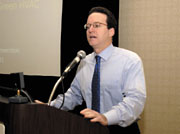“I know some who thought ‘green’ buildings meant you should make money,” said Mass, president of Cosentini Associates, New York, NY. “Or, green buildings bring green [money]. But really, it’s a lot about common sense.”
In his presentation “Designing Green Hvac Systems” at the recent Sheet Metal and Air Conditioning Contractors’ National Association (SMACNA) convention here, Mass defined what goes into a sustainable design, focusing on new hvac technologies, including a system that’s hard to sell to a room full of sheet metal contractors: underfloor air distribution.
“In order to get to the point of building a green building, there must be owner, architect, engineer, and contractor integration,” stressed Mass. “I can’t make a green building. The architect can’t make a green building You can’t make a green building. It has to be a seed that is planted early on in the project. Building a true, green, sustainable building is a process.”

Healthy Is Better
A sustainable, green design must factor in the environment, energy use, materials, reuse of resources, renewables, and future flexibility of the building. There are many reasons for “going green,” said Mass, including possible tax rebates, reduced resource consumption, and reliability. The result, a healthier building, is what matters.“When you build a healthy building — when you’re bringing in better fresh air, better filtered air, better lighting — people will be more productive,” he said. “You will have less absenteeism and a more productive workforce in a green building.”
Mass noted that the U.S. Green Building Council has produced a working definition of, and devised a rating scale for, green building design. Its Leadership to Energy Efficient Design (LEED) Program and rating scale gives certain points for a building’s water efficiency, materials and resources used, indoor environmental quality, site sustainability, and energy and atmosphere.
“You are going to hear more and more about this,” said Mass. “It’s the best definition we have today, and it’s a good, working plan.”
On his list of innovative strategies for sustainable design, Mass included fuel cells, passive single-wall systems, natural ventilation, wind power, solar power, geothermal, peak shaving, cogeneration, photovoltaic, and hybrid systems.
“The evolution of the sustainable design of hvac systems involves applications of new technologies, as well as the application of conventional ideas and systems in a sustainable ‘smart’ manner,” he said.
Changes Needed
Thanks to today’s fast-paced working environment, hvac changes need to be made in a hurry, he said. Due to flex hours, for instance, he noted that more overtime cooling is needed. He also noted that supplementary and 24-hr cooling are on the rise for technology rooms, conference rooms, and high-load areas.Add in the human factor: the fact that employees seek more fresh air and control over their own environments. Mass said the way to meet all of these needs is via sustainable design.
“Changes in technology equal changes in load distribution,” he said. “There also have to be developments of pathways to deal with load migration.
“In the end, we have to have systems that respond to modifications to the physical work environment and that provide fast, low-cost changes.”
Regarding system improvements, Mass said utility costs and availability must figure into the green equation. This entails addressing increased utility costs and potential interruption of service, increased system energy efficiency, and most importantly, improved operating strategies.
“I can design and you can build the most energy-efficient system in the world, but if it is not operated properly, it doesn’t do any good,” said Mass. “I draw the analogy of having your foot on the brake while the other foot is on the gas pedal. That’s the way some buildings operate.”
When affordable, Mass said owners should look into having multiple energy sources or hybrid hvac systems. “We want to reduce our reliances on imported energy,” he said. “That’s part of being green.”
Included in the design mix, he said, should be more attention to the commissioning process. He stressed that communication between the designer and operator should be attended to from the beginning, not at the later stages of building development.
Delivering “a fully functional and verified hvac system that complies with the design intent … calls for everyone being on the same page from the beginning, from the design process on down,” he said. “This also means providing adequate training to building personnel that will allow them to properly maintain and operate these systems. This means turning over proper documentation, showing how the system was designed, installed, and intended to operate.”
New Applications
Mass pointed out several sustainable design case studies, including Four Times Square in the heart of Manhattan. Included in this skyscraper are PV and fuel cell systems; low-emission, CFC-free chillers; a specially designed ventilation system that provides good IAQ; ample facilities for recycling office waste; and tenant-controlled air-handling units.Underfloor Systems
He also discussed the underfloor air distribution system at Owens Corning’s world headquarters in Toledo, OH. Much to the dissatisfaction of his audience, Mass described the system as “the system of the future” because it improves air movement and lets occupants regulate airflow and temperature. This, in turn, can lead to increased productivity, he said.Added benefits include increased ventilation effectiveness, a cleaner environment, easy access for maintenance, and additional air-side free-cooling hours.
The icing on the cake is the fact that an underfloor system allows modular power cabling and modular data telecommunications distribution to go under the floor, too.
“The underfloor system actually takes less energy and lowers maintenance costs,” said Mass. “They [Owens Corning] have a very, very flexible system. They don’t have to tear down walls or move ductwork. They don’t have to wait months to change. All they have to do is move some grilles and partitions.”
Publication date:11/19/2001



